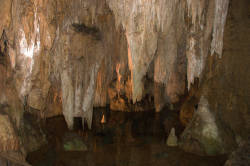芙蓉洞
Furong Dong - Hibiscus Cave - Lotus Flower Cave
Useful Information
| Location: |
Jiangkou Town, Wulong County, Chongqing
(29.228904, 107.903455) |
| Open: |
NOV to FEB daily 9-16. MAR to OCT daily 8:30-16:30. [2021] |
| Fee: |
NOV to FEB:
Adults CNY 65. MAR to OCT: Adults CNY 120. [2021] |
| Classification: |
 Karst Cave Karst Cave
|
| Light: |
 Electric Light Electric Light
 Coloured Light Coloured Light
|
| Dimension: | L=2,846 m, VR=229 m, T=16 °C, A=433 m asl. Biggest room: Ar=11,000 m². |
| Guided tours: | L=1,846 m, V=300,000/a [2000] |
| Photography: | |
| Accessibility: | |
| Bibliography: |
Xuewen Zhu (1994):
The speleothems in Furong Cave,
Carsologia sinica, Vol.13 No.4 / Dec. 1994: 357-368 + 2 pag. with plates (2 tab., 4 figs., 23 colour. photos) (chinese; engl. summ.).
|
| Address: | Furong Dong, No. 88 Furong Road, Xiangkou Town, Wulong County, Chongqing, Tel: +86-23-7774-1075. |
| As far as we know this information was accurate when it was published (see years in brackets), but may have changed since then. Please check rates and details directly with the companies in question if you need more recent info. |
|
History
| MAY-1993 | first exploration by locals. |
| MAY-1994 | opened to the public. |
| 2002 | declared a national 4A tourist site. |
| OCT-2003 | Wulong Karst declared a National GeoPark. |
| 2007 | inscribed on the UNESCO World Heritage List. |
| 2011 | listed as a national 5A tourist attraction in China. |
Description

芙蓉洞 (Furong Dong, Lotus Cave, Hibiscus Cave) is named after nearby Furong river (Lotus river), a tributary of Wujiang river. It is located close to the village Jiangkou in in Wulong County in Chongqing. It is also called 武隆芙蓉洞 (Wulong Furong Cave) to avoid misunderstandings. The cave was originally named Vapor Cave, because the huge entrance gives off steam in winter and cool air in summer, so it is wreathed in mist all year. The thundering sound from the cave opening is the reason for numerous creepy stories about the cave, and the locals were too fearful to enter it. When locals first explored the cave in MAY 1993, they discovered a beautiful cave and decided to open it to the public. Only one year later, in MAY 1994, the show cave was opened to the public. The cave is entered through a long artificial tunnel.
During the 19th and early 20th century it was common to develop caves without previous scientific exploration. Today western nations have rigorous rules for the protection of caves, and the development of new caves requires intensive scientific research first. In China, it is still like 19th century Europe. After the development and inauguration of this cave, its existence became widely known, which resulted in first scientific explorations. An international team of cavers explored the cave, and after five expeditions with a total of 108 days the cave is now surveyed.
The cave tour shows three different chambers, which are mostly 30 m to 50 m wide and about the same height. The main passage is about 2.4 km long and normally 12 m to 15 m wide and 8 m to 25 m high. The biggest chamber on the tour named 辉煌大厅 (Hall of Splendour) is 69 m wide and 50 m high, it is said to have an area of 11,000 m². The cave has numerous strange speleothems made of calcite and also gypsum formations. Notable is a huge flowstone formation which is 16 m wide and 21 m high and resembles a frozen waterfall. There are numerous lakes wit dogtooth spars, huge triangular calcite crystals looking like teeth. The biggest is the 珊瑚瑶池 (Coral Yao Pool) with spectacular calcite crystals, floating rafts and cave coral. The pool has a size of 30 m² and is between 0.5 m and 1.3 m deep.
Furong Cave was formed in Cambrian dolomitic limestone during the Pleistocene, about a million years ago. The whole area surrounding the cave is karstified. There are numerous other caves and karst features. Near the entrance is a natural bridge of impressive size, the ruin of a former cave passage. More information is available at the Wulong Karst Area Tourist Center at the cave entrance.
Like all chinese caves the descriptions on the web and the guides are quite baroque, the light brightly coloured. Also, they tend to inform about the names of formations which they call landscapes, instead of scientific facts. The operators are quite happy to inform us that the only plants that grow in Furong Cave are ferns and 11 species of mosses, which are found in the Dragon Palace. What they omit is the fact that this is called Lampenflora, is a result of the electric light, and generally considered a bad thing. Not really surprising, as they also inform us also of more than 20 types of stalactites and 70 kinds of secondary chemical sediments and of the numerous national prices it has won. The Chinese audience is very fond of it.
 Subterranean World Heritage List
Subterranean World Heritage List Search DuckDuckGo for "Furong Dong"
Search DuckDuckGo for "Furong Dong" Google Earth Placemark
Google Earth Placemark Furong Cave - Wikipedia (visited: 27-AUG-2021)
Furong Cave - Wikipedia (visited: 27-AUG-2021) Furongdong - 芙蓉洞 - Grottes et karsts de Chine (visited: 14-OCT-2010)
Furongdong - 芙蓉洞 - Grottes et karsts de Chine (visited: 14-OCT-2010) Index
Index Topics
Topics Hierarchical
Hierarchical Countries
Countries Maps
Maps